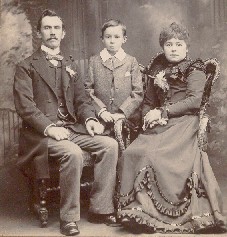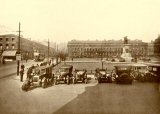Synopsis
 A church of Christ in Newcastle can be traced to 1824. It is
noted that two of the key players, Robert Banks and William
Dickinson, had left the Scotch Baptists in 1824, and moved from
New Court Baptist Chapel to form a congregation in the Weavers
Tower, New Bridge Street. (The site of the Library). The reasons
for the secession in 1824 were "That the Church does not
exercise the gifts of its members in exhortation and refuses to
examine the Scriptures in the Weekly Communion and a Plurality of
elders".
A church of Christ in Newcastle can be traced to 1824. It is
noted that two of the key players, Robert Banks and William
Dickinson, had left the Scotch Baptists in 1824, and moved from
New Court Baptist Chapel to form a congregation in the Weavers
Tower, New Bridge Street. (The site of the Library). The reasons
for the secession in 1824 were "That the Church does not
exercise the gifts of its members in exhortation and refuses to
examine the Scriptures in the Weekly Communion and a Plurality of
elders".
 On the
03 February
1839, eight people left the church in New
Bridge Street, and met at St Nicholas Square. This was when
another church of Christ was formed in Newcastle. On the 10
February 1839, they had someone place membership in the morning,
and in the afternoon, a former member and manager of a
Presbyterian church was baptised into Christ.
On the
03 February
1839, eight people left the church in New
Bridge Street, and met at St Nicholas Square. This was when
another church of Christ was formed in Newcastle. On the 10
February 1839, they had someone place membership in the morning,
and in the afternoon, a former member and manager of a
Presbyterian church was baptised into Christ.
The start of this congregation was notified by James Briggs on
the 14th of February, to the Christian Messenger and Reformer.
This was a magazine first produced by the Nottingham Church of
Christ in 1837. However, the Christian Messenger and Reformer
were informed of his death on the 24th October 1839, by which
time the congregation numbered twenty three.
 This congregation moved to Westgate Street, and then to the
Cordwainers Hall in the Friars. On 01 May 1853, this
congregation merged with the congregation in New Bridge Street.
The united church then met at a chapel in New Bridge Street, at
the corner of Picton Terrace.
This congregation moved to Westgate Street, and then to the
Cordwainers Hall in the Friars. On 01 May 1853, this
congregation merged with the congregation in New Bridge Street.
The united church then met at a chapel in New Bridge Street, at
the corner of Picton Terrace.
The union only lasted until 01 March 1854, when a split arose
as to the mode of receiving members. One group went to various
places and eventually back to the Cordwainers hall in the Friars.
This split was eventually healed when Mr. Daniel Collin managed
to obtain a reconciliation between the two congregations. Some of
the New Bridge Street members transferred to the Cordwainers
hall, while Robert Banks, and his friends remained at the New
Bridge Street site until the chapel was sold.

The foundation stone of a new chapel at 73 Gloucester Street,
was laid by Mrs Jane Watson in 1868. The building in Gloucester
street, called "The Christians Meeting House", was
opened on the 24 January 1869, and had cost fifteen hundred
pounds to construct.
The leaders of the Newcastle movement were William McDougall,
William Patrick and Joseph Moffit. Mr. Mason Watson had been an
elder in the New Bridge Street congregation in 1851, and had
later resigned. Mason Watson was re-elected as an elder on the
26 May 1878. Daniel Scott, although he was not one of the
leaders, had been another elder for a time, and was an
evangelist.
Most of these men had professions. Mason Watson was listed as
a Surgeon Dentist and a then as a land agent, William McDougall
was listed as a butcher in 1871 and then as a Gentleman in 1873.
There were two William Patricks listed in 1881, one was a
butcher, the other a fruit merchant. Joseph Moffit worked for a
firm, Currie M & Co.
On the 27 September 1884 a piece about the Christian's
Meeting House and the Newcastle church of Christ appeared in the
Weekly Chronicle. This was part of a series of articles about
churches in the Newcastle area. By the 18 October 1884, members of
the church wrote to the editor over errors of fact.
In 1898, the Newcastle church of Christ applied for approval
to put in a lavatory, and at that time a Mr Ditchburn was listed
as an owner. The Architect was a Mr. Arthur Stockwell, of 11
Pilgrim Street. He later went into business with a David
Ditchburn between 1924 and 1932.
By 1898, there were two Mr. Ditchburns connected with the
church. John Ditchburn senior who lived with his daughters in 30
Lawton Street, and his eldest son John Robert Ditchburn, who
lived at 341 Scotswood Road. Both worked in the grocery Trade.
John (Snr) as the owner of a grocery shop and John Robert as an
assistant.
John Robert Ditchburn had married his fiancée, Elizabeth Laura
Vincent on the 21st May 1888, at The Christian's Meeting House.
They had their first child, John Oscar Ditchburn on the 14th of
May 1889. There were to be no further surviving children. After
the death of Elizabeth, John Robert and John Oscar moved back
into the family home of 30 Lawton Street.
John Oscar Ditchburn married his fiancée, Mary Jackson Young
Stoker in the last quarter of 1933. Mary died on the 14 December 1982 at the age of 82. John Oscar died on 26 August 1983. No children were born from this marriage.
Two of the daughters of John Ditchburn Senior Jessie and Mary
Ditchburn both became fruiterers and stayed in the family home in
Lawton Street. Jessie Ditchburn's shop in 1924 at 115
Westmoreland Road, and Mary's shop in 1930 at 53 Stanley Street.
They both disappeared after 1940
Apostasy crept into the Gloucester Street congregation in the
early twentieth century, when in spite of the objections of the
older members, instrumental music was introduced into worship.
First came a piano, and then an organ.

With some congregations, the advent of World War II caused them to become
extinct as men were called up to fight, but this did not quite happen with the
Newcastle congregation.
The building continued to be listed as the Christians Meeting house in trade
directories, until 1940. According to the minutes of the church meeting around
the beginning of 1946 there were problems with the boiler in the church building
and one member was tasked with getting quotes for a repair. On 22 January 1946
at a church meeting, the decision to select a contractor to repair the boiler
was put in abeyance when it was reported that an offer for the building had been
made of about £1500.
On 05 February
1946, it was decided to accept the offer for the building and that the last
service would be on Sunday 17 February 1946. The following Sunday the congregation
moved to 12 Eldon Square. Originally, they hoped to be there, for only three
months. The congregation continued to meet at 12 Eldon Square area and efforts
were made to look for a new building or a new meeting place with no luck. Even
an advert in the Newcastle Evening Chronicle for a new hall drew a blank. The
congregation would continue to meet at 12 Eldon Square until it’s end
In 1947 the building was listed as a warehouse for a furniture company. The
building was finally scheduled for demolition after 1964 in a general clearance
of Gloucester Street, for new housing, when the road became Gloucester Way.
In an interview with Mr. David Black, the last preacher of the first planting of
the Newcastle church of Christ, conducted in 1996, he recounted how he continued
with congregation until he moved away in 1950. The congregation consisted only
of elderly people and only carried on at 12 Eldon Square for only one year.
On 24 January 1951, a letter was sent out by Honorary Secretary Angus Kennedy to
a number of people and congregations, proposing the closure of the Newcastle
church of Christ. The decision was made to close the congregation at the church
business meeting on 11 February 1951, with the final meeting church meeting being recorded as
Sunday 03 June 1951
According to an interview with a minister from the United Reformed Church, the
church ended its days meeting in a ground floor room in one of the properties on
the East side of Old Eldon Square, but this does not tally with the last set of
minutes for church business meetings and Office holders meetings lodged with the
Tyne and Wear Archives which has them finishing at 12 Eldon Square,
The end of the first congregation of the Newcastle church of Christ can now be
put at 03 June 1951 This means that a church of Christ existed in Newcastle for
127 years before it became extinct. The minutes of the church ended up at Selly
Oak College in 1979, and found their way to the
Tyne and Wear Archives.
(Where they can be looked at under the reference number C.NC114)
In 1976 The Eldon Square area was redeveloped into the modern-day Intu Eldon
Square shopping centre, meaning that 12 Eldon Square no longer exists and was
approximately where the Starbuck Coffee shop is today
What part the introduction of instrumental music in worship contributed to the
extinction is unknown, but it must be remembered that the Ephesians who lost
their first love, were warned that if they did not repent, then the Lord would
remove "their lamp stand" (Revelation 2:5).
Some other congregations did continue in the area, but they disappeared when
they joined up with the United Reform Church in 1981.
There would not
be a congregation of a church of Christ in Newcastle until 1985, but that's
another story.
 A church of Christ in Newcastle can be traced to 1824. It is
noted that two of the key players, Robert Banks and William
Dickinson, had left the Scotch Baptists in 1824, and moved from
New Court Baptist Chapel to form a congregation in the Weavers
Tower, New Bridge Street. (The site of the Library). The reasons
for the secession in 1824 were "That the Church does not
exercise the gifts of its members in exhortation and refuses to
examine the Scriptures in the Weekly Communion and a Plurality of
elders".
A church of Christ in Newcastle can be traced to 1824. It is
noted that two of the key players, Robert Banks and William
Dickinson, had left the Scotch Baptists in 1824, and moved from
New Court Baptist Chapel to form a congregation in the Weavers
Tower, New Bridge Street. (The site of the Library). The reasons
for the secession in 1824 were "That the Church does not
exercise the gifts of its members in exhortation and refuses to
examine the Scriptures in the Weekly Communion and a Plurality of
elders".



